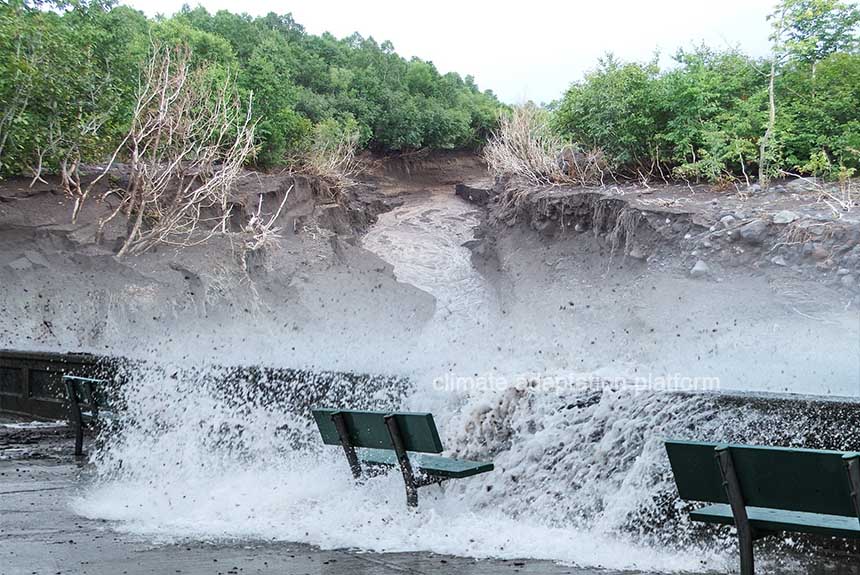Maladaptation occurs when climate adaptation projects worsen the effects of climate change instead of reducing its impacts. It also refers “to the unintended consequences of well-meant measures to reduce climate vulnerability” (Chakraborty & Burgess, 2023).
When this happens, the most vulnerable members of our community suffer the most.
The Conversation cites some examples of maladaptation and its adverse impacts on the communities it purports to protect. In Fiji, the US-funded seawall that is supposed to shield residents from rising tides had trapped water and debris inland and blocked water inland instead. The US$400 million World Bank-funded flood barriers in Bangladesh have caused water-logged fields and degraded their soils.
The article notes that Climate adaptation research in New Zealand is still in its nascent stages. Most adaptation projects focus on flood protection, such as stop banks and erosion control, nature-based solutions like tree planting and wetland restoration, and coastal hazard prevention, such as managed retreats and building sea walls. However, these projects need to be flexible and adaptable to new information.
A recent stocktake of these measures reveals some critical points, including the need to involve Māori and local communities more throughout the process, share governance across all levels of government, address funding barriers for implementation, and avoid investments that lock in problems for the future.
The article cites the Clifton to Tangoio Coastal Hazard Strategy 2120 of Hawke’s Bay, a cross-council approach to identifying and responding to coastal hazards. The strategy faced policy and funding issues, and in February 2023, cyclone Gabrielle brought devastation to the region, dubbed the country’s worst storm in a century, leaving areas and residential properties uninhabitable.
Now, the region is in the cyclone recovery phase. Vital infrastructure has been restored, and resilience will be built into its highway networks and critical infrastructure. The region is also in the process of developing an environmental resilience plan and Long-term plans. It aims to make it a community-driven plan and actively seeks input and views from the community.
But how can councils and communities ensure that the climate adaptation projects and solutions will not result in maladaptation in the future?
A group of Māori (Indigenous people of New Zealand), Pasifika (migrants from the Pacific regions and their descendants), Pākehā (white New Zealander), and tau iwi (non-Māori people of New Zealand) and practitioners have drawn up a new assessment tool that assesses maladaptation.
The tool “aims to correct overlooked social and ecological impacts of climate adaptation and address the limits of the current audit system.”.
Government-led adaptation solutions such as managed retreat, structural flood protection,n and climate-resilient development are at risk of maladaptation because they apply a top-down approach that often overlooks local justice and wellbeing, particularly of minority groups and indigenous peoples.
According to the authors of the assessment tool, “To be just, climate adaptation requires a counter-intuitive approach. It should prioritise community wellbeing and examine climate change risk and adaptation.”
“This perspective doesn’t diminish the reality of climate impacts. It contextualises them within a complex history of Indigenous displacement, forced landscape alteration“.
Sources:
Chakraborty, R., & Burgess, C. (2023, October 30). Climate adaptation projects sometimes exacerbate the problems they try to solve – a new tool hopes to correct that. Retrieved from https://theconversation.com/climate-adaptation-projects-sometimes-exacerbate-the-problems-they-try-to-solve-a-new-tool-hopes-to-correct-that-213969
Assessing climate adaptation for holistic and justice-based solutions. (n.d.). Just and Holistic Adaptation. Retrieved from https://www.justadaptationtools.org/
Hawke’s Bay cyclone recovery. (2023). NZ Transport Agency. Retrieved from https://www.nzta.govt.nz/projects/hawkes-bay-cyclone-recovery/
A Vision for Environmental Resilience in Hawke’s Bay. (n.d.). Hawke’s Bay Regional Council. Retrieved from https://hbrc.mysocialpinpoint.com/hawkesbay-environmental-resilience/hawkes-bay-environmental-resilience



Leave a Reply